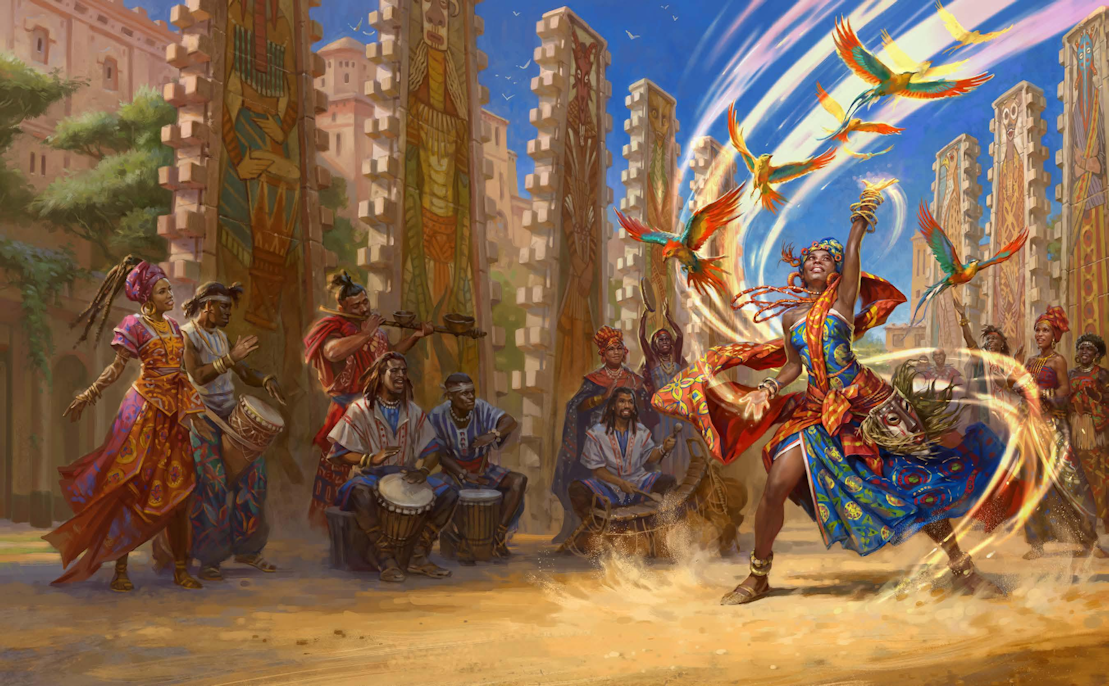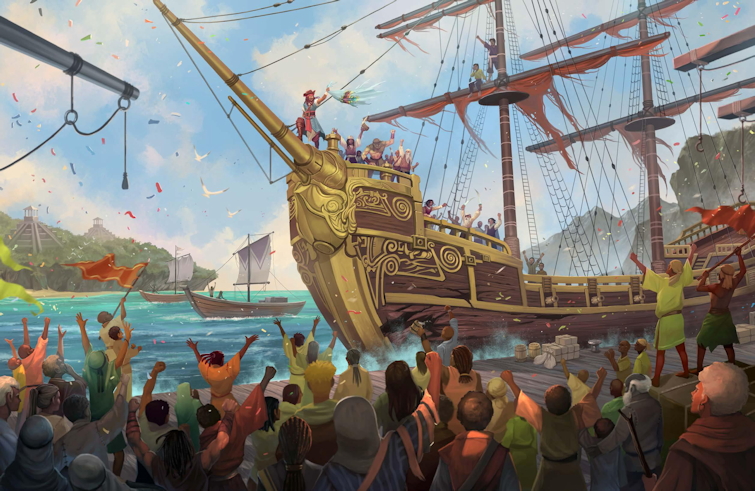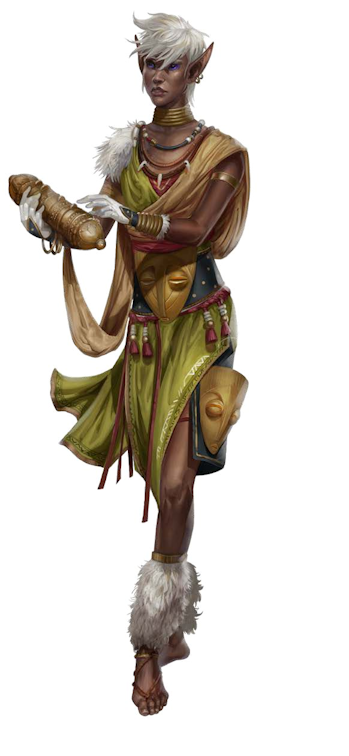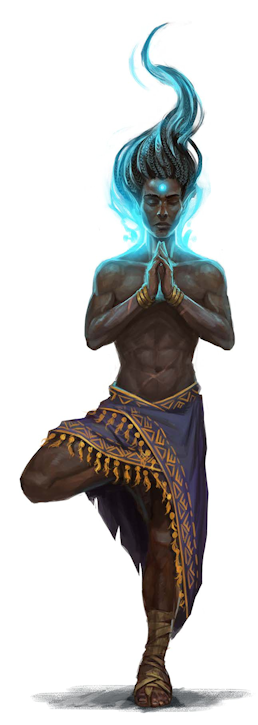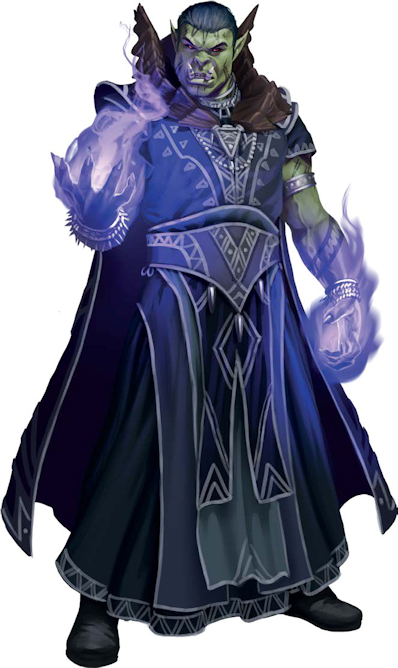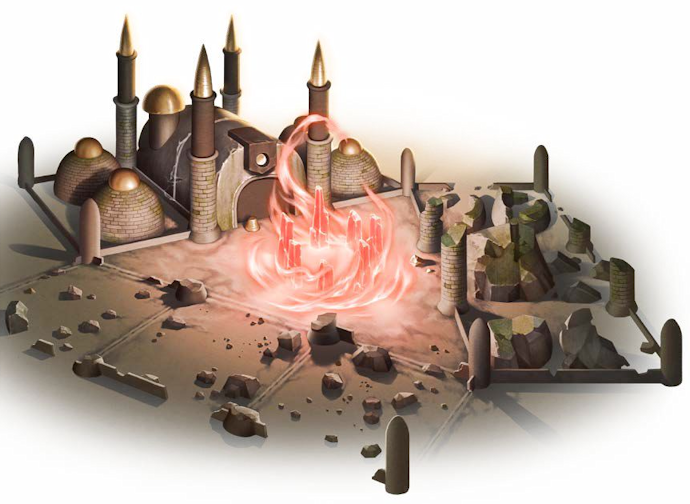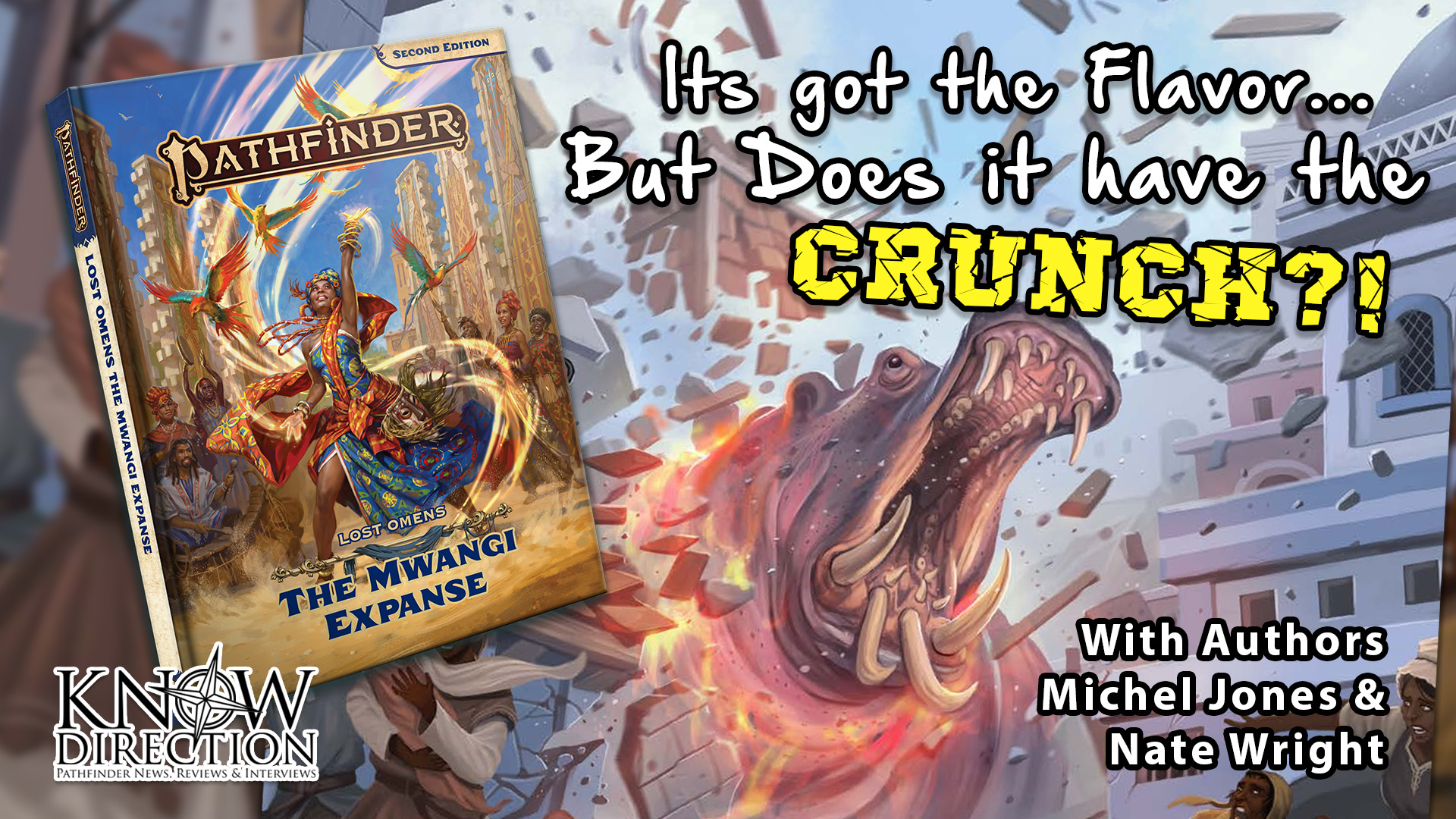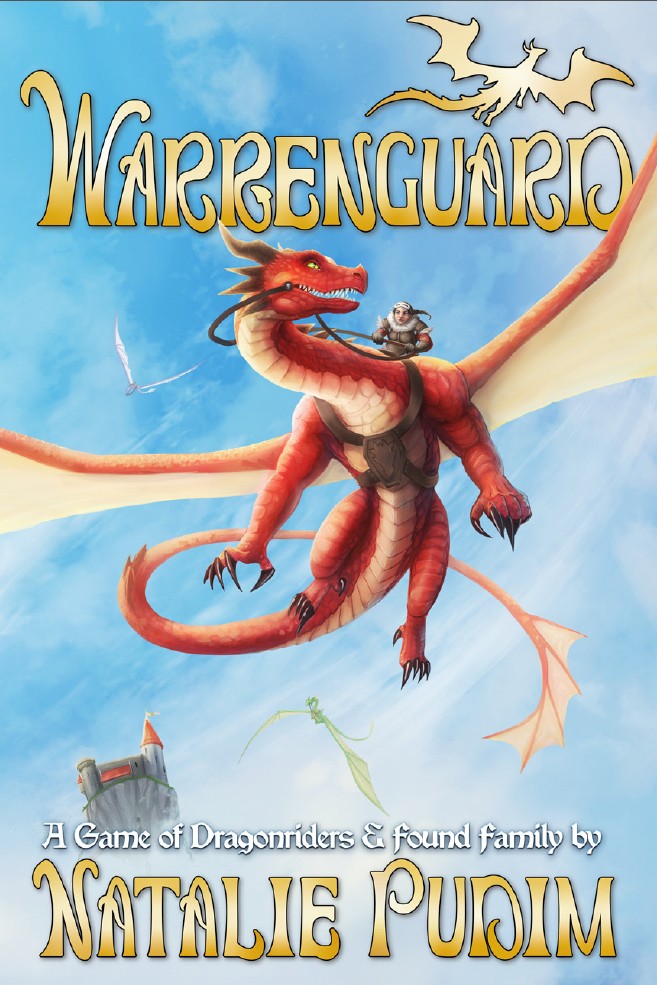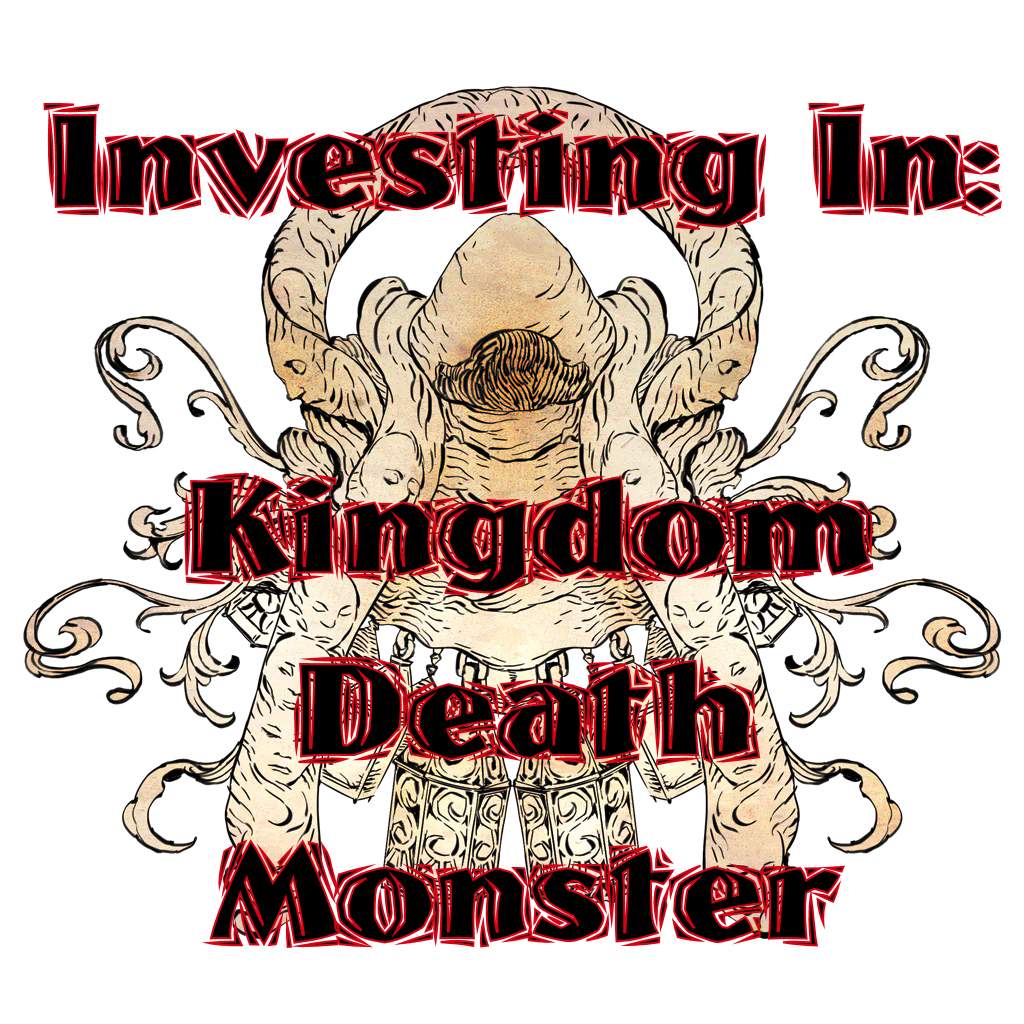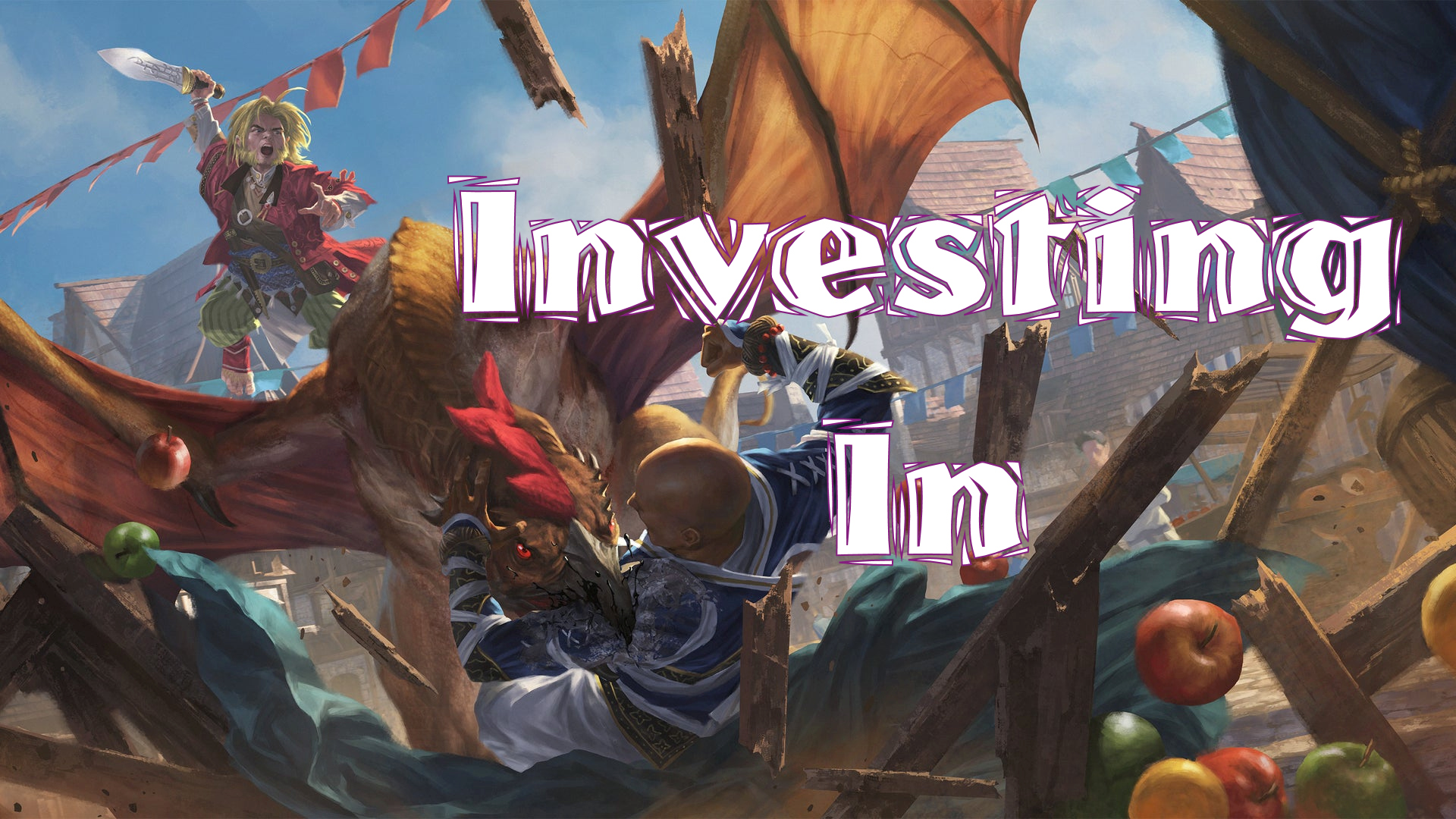“The Mwangi Expanse has a way of keeping invasive outsiders humble. Wanton ambitions often prove no match for the beauty and cruelty of nature here, or the countless ancient secrets that lie within. The jungle hides enough ruins of past follies to deter even the most voraciously greedy of Golarion’s so-called civilized peoples, dating back before even Earthfall. The small number of coherent maps for such an old frontier is no coincidence. To venture this land unguided spells certain misfortune for all but the most expert of survivalists.
This region is far kinder to the well prepared and warmly curious. The myriad indigenous people who thrive within even the deepest parts of the region hold a more intuitive understanding of their surroundings’ geography and communities. In some of the Expanse’s better-known cities, such as Nantambu and Kibwe, the cultural depth matches the vast breadth of diversity that marks the whole of the Expanse, let alone the Inner Sea region. These communities are willing to share with those outsiders who listen.”1
Today we’re exploring more of The Mwangi Expanse from Eleanor Ferron and Luis Loza. There’s much to see and love about this book, let alone the land and its people. As I said last time it’s an excellent addition to the source books for Golarion, specifically the world-building for the Age of Lost Omens. There are a number of details I’ve picked out specifically of interest to me or that I’ll be sure to bring into the Expedition Coalition game I run for my friends as I’ve brought up in the past. I’m thrilled to talk a bit about those and show even more fantastic creativity through the writing and art supporting these details!
Also last time I talked about how the Mwangi Expanse is Exciting, Not Exotic – a highlighted box of text there on page 7. A friend of mine (also named Rob) brought it up to me before he’d even read my article so I will call it out again for celebrating all that has gone into the Mwangi Expanse both real and imagined by the creators. I also appreciate the two highlighted areas later in the chapter about Questioning Outsiders – details for those visiting the Expanse – and No Place Like Home for those who are from the area. Although perhaps even if you do have a character native to the Mwangi expanse, you’ve been away or many things are still mysterious to you. There’s a question in that blurb for that and let me tell you, there are a great many secrets in the pages that follow!
Many People
Chapter 2 immediately offers you some of those Lost Omens secrets by delving into the History. The presence of the Anadi in the early days of the Magaambya is an excellent detail; they themselves lead secret lives within the rest of civilization due to the fear others project onto them with violence due to their nature as spider-like beings. Besides that sad (but I’m hopeful) detail there was a sidebar – I do love the sidebar callouts Paizo! – about the Troubling Visitors. Turns out the Aspis Consortium has had troubled dealings with the Mwangi Expanse. Are we shocked? No. Are we surprised some of them lived? Yes! In fact apparently a number of them lived. The kind people of Osibu allowed those Aspis agents that discovered their secret paradise and the alleged fountain of youth a chance to remember, change their vile ways, and stay or be drugged beyond memory of the place and allowed to leave. Most left but a couple stayed and I applaud the idea that a couple could find wisdom in the offerings of Osibu’s leadership. Of course I’m also quite excited for others to go looking for Osibu, perhaps even the players in my game!
Then there’s the NPCs of the Mwangi detailed in the third chapter: People of the Mwangi. Zolha is absolutely amazing and they are one of my new favorites NPCs. I absolutely adore the detail worked into the character – who has an entire page dedicated to them – as it’s noted they loved to hear tales of new lands they’ve not experienced, always seeking to learn because of their nature as an archivist. Perhaps you also noted their pronouns? Zolha is nonbinary and I greatly appreciate the representation in this book as we expect to see in Paizo releases. This elven native of Nagisa is a historian who rarely travels due to the demonic attack they witnessed against their traveling companions. I can guarantee that the characters in our Expedition Coalition game will be meeting Zolha even if they’re a little standoffish at first meeting. Considering Zolha is looking for some heroes to help in a few tasks, I’m sure they’ll all get along quite well especially as each has a story to tell of their home.
Zolha is a member of the Alijae: one sect of Mualijae elves who feel they take the rights means – whatever they are – to fight demons who threaten them and their city. Then there’s the Ekujae elves who dwell within the jungles of the Expanse, known for scholarly experience of the world and guardianships of the wilds. They’re concerned with Ekujae’s disregard for their once sacred traditions and the sharing of ancients secrets, let alone a bit too much finery in their clothing and decoration. The Kallijae however particularly caught my eye. This third sect of elves broke off due to a concern of ancient evil awakening with their elven population (all of the Mualijae actually) due to their disconnect with the wider world and their long lifespans. They have a couple sidebars that caught my attention beyond my excitement at reading into the elven cultures and their fractioned past. One is about their Respect For Life, noting that binding of any creature invites evil. No familiars, no summoning magic, no compulsions with enchantment magic, etc. There’s also the note about Elven Iron. While they need cold iron weapons in their dedicated fight against evil, particularly demons, they are very respectful of nature and what pollution can come of forging such weapons. They regulate the process of crafting and where it can be done and the byproducts are recycled into the environment. I love the juxtaposition set up here over the concern for demonic dangers and yet complexities of the civilizations in the Mwangi Expanse’s elven cultures that grew from different methodologies of how to approach those dangers. I’m sure my players will too.
It’s not all elves of course. There are numerous ancestries both familiar – humans, elves, gnomes – and new – anadi, conrasu, goloma – presented in the Mwangi Expanse. Another section that caught my eye is the Matanji: orcs native to the Mwangi Expanse with a very rich culture of protection and demon hunting/fighting. These orcs didn’t war with the humans and others within the jungle. No, in fact, there’s a detail about how others have a sense of security when the Matanji are around. Also half-orcs in the Matanji are praised and given more educational opportunities. These Witanji are valued for their education and dedication to their people, but also because they often represent a marriage or symbol of various political joinings that also trace back in history. While not a Watanji, Morklau Hornbreaker has fathered many of them but it’s more his history as a spoiled aristocrat that realized he’d been influence by demonic presences, but embraced those sorcerous powers to take action, fight demons, and help his people. I love his art and I love his story – 67 children and more on the way – in how he hopes to bring others together and continue teaching how to fight evil. He brings a personal touch to this already amazing section and I can’t wait to be able to roleplay him as an NPC meeting the heroes in our game.
Many Places
But not all mysteries investigated lead to heroism, success, and large families. Some reveal how entire families have vanished, much like the case of Darkreach. It wasn’t even a hundred years ago – merely decades – that someone sought to establish this city there in the Bandu Hills near the Ocota River. Only a few miles from those charred city remains is a titanic statue of black perhaps marble streaked with green. It’s been there far longer and is still visible due to its monstrous size with an inscription informing all: “I point the way to Zurakai, never there to return.” Whatever happened to Zurakai, no one knows. Perhaps the same thing that happened to Darkreach? There’s danger in the Mwangi Expanse and some of those dangers are still too unknown millennia later, still finding new explorers today.
It’s not all darkness and despair however. Some cities were lost but have been reclaimed, though maybe too many eyes have fallen on some particular venues. Take Saventh-Yhi. It was here the Azlanti heroine Savith slew Ydersius, the likely still living immortal god of the serpentfolk, even if their head is now missing because of that battle. Seven magical ziggurats protected the city. However these Seven Spears couldn’t stop Earthfall. Thankfully, explorers have found the city and the secret of it has spread throughout the Expanse and beyond. Problem is all number of individuals like tomb robbers and scholars, groups like Pathfinders and New Thassilonians, have come to Saventh-Yhi. There’s even a serpentfolk named Sziskazha hiding in disguise and I imagine they might be a worshipper of Ydersius who’d love if her people could have access to the ancient ancestral city of Ilmurea beneath. Great danger rests around every corner and I love the adventurous opportunity it presents. As noted in the pages of the Mwangi Expanse it’s “a powder keg waiting only for a match.”7 Well let me tell you, I intend to light one.
It’s truly a gift to explore these majestic lands and learn of the wondrous people of the Mwangi Expanse. I find it interesting that these rarely explored lands might be treated with an exploitative approach, favoring the exotic offerings rather than focus on the exciting history and culture present. These civilizations have been nurturing the land, fighting back demons, and protecting a home – one might say all of Golarion – while others balk at fountains of youth and riches within the jungle. Truly the “warmly curious” will be rewarded, much as the first chapter notes, and so too will you. Like the cities of Natambu and Kibwe, there’s much to invest in and share with your players and GMs due to the exquisite world-building and stories brought in the Age of Lost Omens by the Mwangi Expanse.
Investing In:
I wasn’t quite sure what to name my article series when I first started but the idea of showcasing or discussing things that make me excited, that I find new and interesting, or maybe I’m otherwise passionate about seemed to fit with the idea of Investing In something like the Pathfinder 2E mechanic. To use some magic items you have to give that little bit of yourself, which helps make these things even better. I like the metaphor of the community growing and being strengthened in the same way!
I also want to hear what you’re Investing In! Leave me a comment below about what games, modules, systems, products, people, live streams, etc you enjoy! You can also hit me up on social media as silentinfinity. I want to hear what excites you and what you’re passionate about. There’s so much wonderful content, people, groups (I could go on) in this community of ours that the more we invest in and share, the better it becomes!
Sources
Banner – The Mwangi Expanse cover art, Paizo, by Ekaterina Burmak
- Reclaiming the Expanse excerpt, The Mwangi Expanse, Paizo
- The ship from The Mwangi Expanse foreart, The Mwangi Expanse, Paizo
- Zolha, The Mwangi Expanse, Paizo
- Kallijae elf in meditation, The Mwangi Expanse, Paizo
- Morklau, The Mwangi Expanse, Paizo
- Darkreach statue, The Mwangi Expanse, Paizo
- Saventh-Yhi excerpt, The Mwangi Expanse, Paizo
- Saventh-Yhi, The Mwangi Expanse, Paizo

